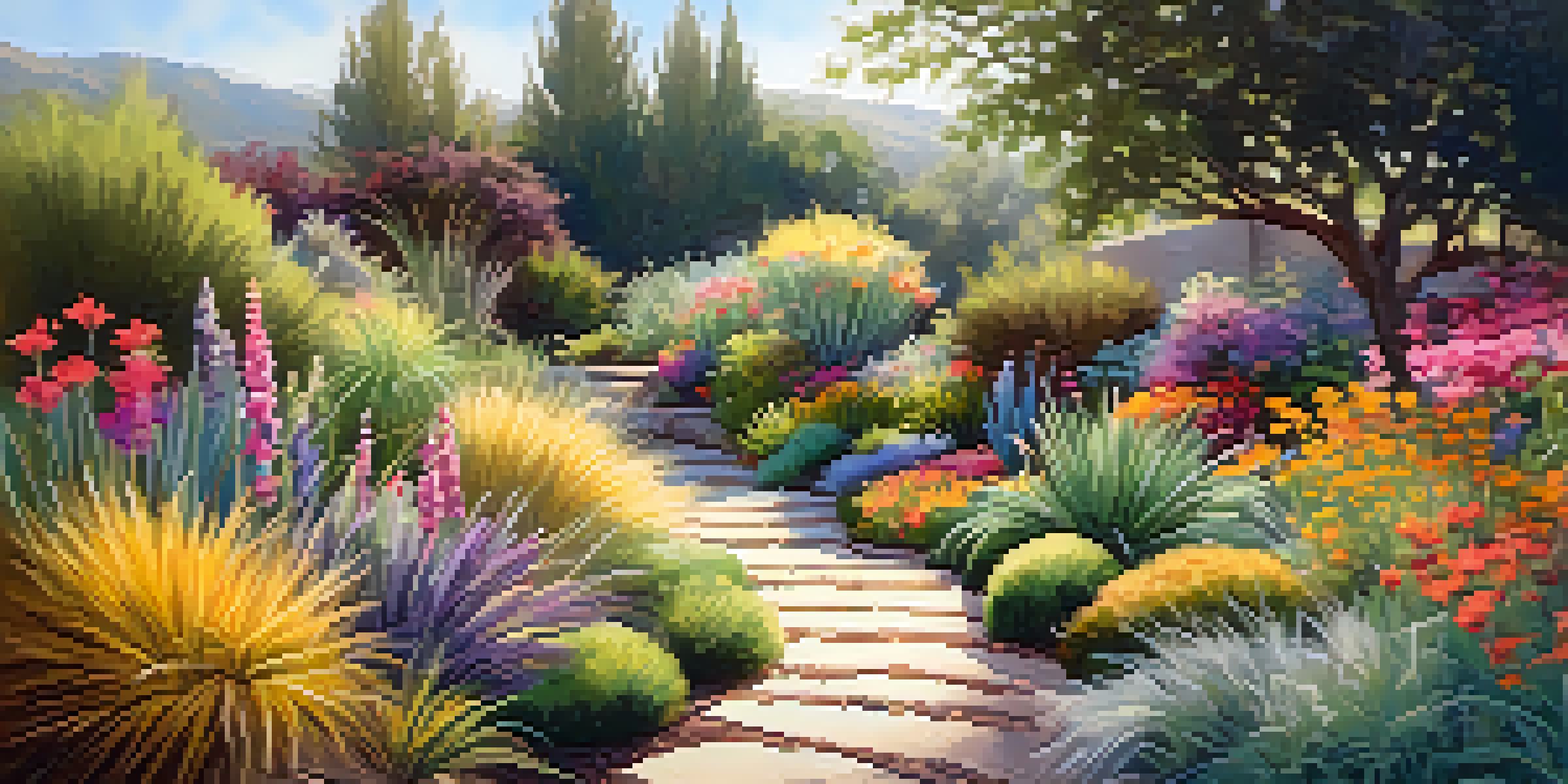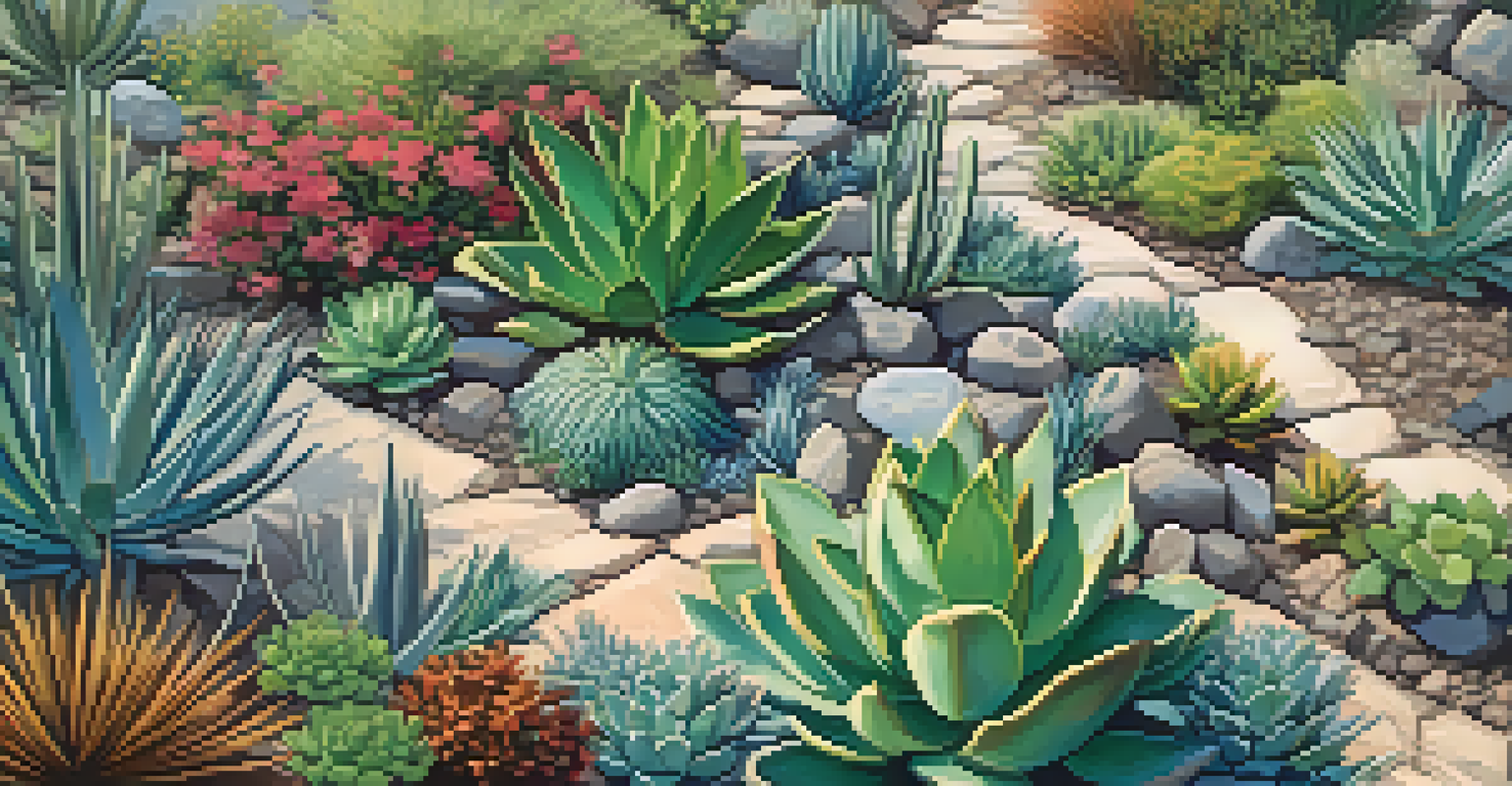Drought-Resistant Plants: A Solution for Water-Saving Landscapes

Understanding Drought-Resistant Plants and Their Benefits
Drought-resistant plants are species adapted to thrive in low-water conditions. These plants have unique features, such as deep root systems and waxy leaves, which help them conserve moisture. By incorporating these plants into your landscape, you not only create a beautiful garden but also contribute to water conservation efforts.
Nature does not hurry, yet everything is accomplished.
One of the greatest benefits of drought-resistant plants is their ability to reduce the need for frequent watering. This not only saves you time and money but also helps decrease your environmental footprint. Imagine spending less time dragging a hose around the yard and more time enjoying your garden with family and friends.
Moreover, these plants can attract pollinators and provide habitats for local wildlife. A garden filled with vibrant, drought-tolerant flora supports biodiversity and creates a lush ecosystem, making it a win-win for both you and nature.
Choosing the Right Drought-Resistant Plants for Your Area
Selecting the right drought-resistant plants begins with understanding your local climate and soil conditions. Native plants are often the best choice because they are already adapted to the environmental conditions of your area. Researching local species can provide you with valuable insights into which plants will flourish in your garden.

Consider factors like sun exposure, soil type, and the overall moisture levels of your garden. For instance, succulents thrive in sunny, well-drained areas, while some grasses may prefer slightly shadier spots. This knowledge will help you create a harmonious landscape that requires minimal maintenance.
Benefits of Drought-Resistant Plants
Incorporating drought-resistant plants in your garden reduces watering needs, saves time and money, and supports local wildlife.
Lastly, visiting local nurseries or botanical gardens can offer inspiration and guidance. You can see firsthand which plants thrive in your area, and knowledgeable staff can provide recommendations tailored to your specific needs.
Designing a Beautiful Drought-Resistant Landscape
Creating a visually appealing drought-resistant landscape can be both fun and rewarding. Start by incorporating a variety of textures and colors to add depth to your garden. For example, pairing the vibrant hues of flowering perennials with the soft greens of ornamental grasses can create a stunning contrast.
The greatest threat to our planet is the belief that someone else will save it.
Layering plants in your design can enhance visual interest. Taller plants can serve as a backdrop, while shorter ones fill in the front, creating a sense of dimension. Additionally, consider using pathways or decorative rocks to break up the space and provide structure to your layout.
Don't forget about the importance of seasonal changes. By selecting plants that bloom at different times, you can ensure that your landscape remains vibrant throughout the year. This thoughtful approach keeps your garden lively and engaging, making it a delightful space to explore.
Watering Techniques for Drought-Resistant Plants
Even drought-resistant plants need some water, especially during their initial establishment period. A deep watering once or twice a week encourages strong root growth and helps them adapt to their new environment. This initial care will set them up for success as they become more resilient over time.
Using mulch can significantly reduce the amount of water your garden needs. Mulch acts as a barrier that prevents moisture loss from the soil, while also suppressing weeds that compete for water and nutrients. A layer of organic mulch not only improves the health of your plants but also reduces your overall watering frequency.
Choosing Suitable Plants
Selecting native and climate-appropriate drought-resistant plants enhances your garden's success and minimizes maintenance.
Lastly, consider implementing drip irrigation systems or rainwater harvesting techniques. These methods deliver water directly to the plant roots, minimizing evaporation and runoff. By making these small adjustments, you can create a more efficient watering routine that supports your drought-resistant garden.
Common Misconceptions About Drought-Resistant Plants
Many people believe that drought-resistant plants are dull and lack variety, but that couldn't be further from the truth. In reality, there are countless species available, ranging from vibrant flowers to unique foliage. This diversity allows you to create a stunning and dynamic landscape while adhering to water-saving principles.
Another misconception is that these plants require no care at all. While they are more forgiving during dry spells, they still benefit from regular maintenance such as pruning and deadheading. By giving them a little attention, you can ensure that they stay healthy and continue to thrive in your garden.
Lastly, some may think that drought-resistant gardens are only suitable for arid climates. However, these plants can thrive in a variety of conditions, even in regions that experience seasonal rainfall. With the right planning and care, anyone can incorporate drought-resistant plants into their landscape.
The Environmental Impact of Using Drought-Resistant Plants
By choosing drought-resistant plants, you contribute to a more sustainable environment. These plants help reduce water consumption, which is increasingly important in areas facing water shortages. In turn, this helps preserve local water resources for future generations, making your garden a part of a larger conservation effort.
Additionally, drought-tolerant plants often require fewer fertilizers and pesticides. This reduction in chemical use not only benefits your garden's health but also protects local ecosystems from harmful runoff. A garden that thrives on natural resilience promotes a healthier environment overall.
Environmental Impact and Sustainability
Drought-resistant gardens help conserve water, reduce chemical use, and promote biodiversity, making them an eco-friendly choice.
Finally, supporting native drought-resistant plants helps to maintain biodiversity. As you cultivate a garden filled with local species, you create a sanctuary for wildlife, encouraging pollinators and beneficial insects to flourish. This harmonious relationship between your garden and the ecosystem exemplifies a commitment to environmental stewardship.
Getting Started with Your Drought-Resistant Garden
Starting your journey toward a drought-resistant garden can be exciting and fulfilling. Begin by assessing your current landscape and identifying areas that could benefit from water-efficient plants. Take some time to sketch out a rough plan of your garden, keeping in mind the sun and shade patterns throughout the day.
Next, research and select drought-resistant plants that suit your style and local conditions. Make a list of your favorites, and consider visiting local nurseries or gardening clubs for inspiration. Engaging with fellow gardening enthusiasts can provide valuable tips and boost your confidence as you embark on this new project.

Finally, don't hesitate to experiment and learn as you go. Gardening is a journey, and every small change you make contributes to a more sustainable landscape. Embrace the process, and soon you'll be rewarded with a beautiful, drought-resistant garden that reflects your dedication to both aesthetics and the environment.